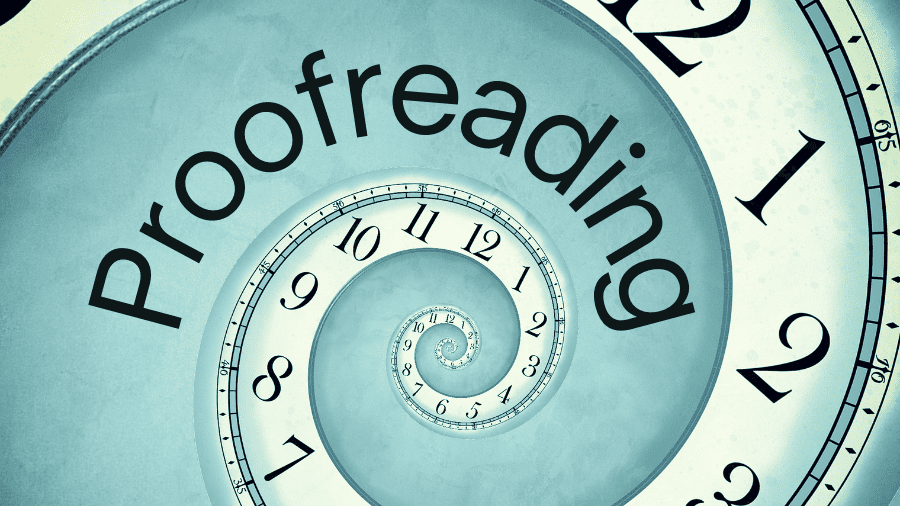This article may contain affiliate links. Please see our affiliate disclaimer in the footer menu for more information. Thank you for your support!

So you’re curious about how long proofreading takes. Whether you need to hire a proofreader or you’re thinking about becoming one, I can give you a complete answer to your query. I work as a proofreader and spend substantial time researching proofreading-related topics.
On average, experienced proofreaders can work through about 2,500 words per hour, which equals ten 250-word pages. That means it would take roughly 25 minutes to proofread 1,000 words. However, due to numerous variables, it can take anywhere from 15–40 minutes to proofread 1,000 words (source).
How long proofreading takes depends on many factors, which is why the range of time to proofread 1,000 words is so broad. Let’s see how long proofreading takes according to the most well-respected sources in the industry.
We’ll also discover the variables that affect a proofreader’s speed.
Note: Please be aware that the proofreading paces in this article assume that a document has already been copyedited. Proofreading is the last step in the editorial process and is meant to catch errors that have slipped through the cracks during other editing stages.
How Long Proofreading Takes according to Credible Sources
To determine how long proofreading takes, I researched the average proofreading pace suggested by four well-known editorial associations.
How Many Words Can Be Proofread per Hour? (On Average)
| Editorial Society | Words per Hour |
|---|---|
| The Editorial Freelancers Association (US) | 2,500 |
| The Chartered Institute for Editing and Proofreading (UK) | 3,000 |
| Editors Canada | 1,625 |
| The Association of Freelance Editors, Proofreaders and Indexers (Ireland) | 3,000 |
If we calculate the overall average from the averages in the table above, we come to a mean proofreading pace of roughly 2,500 words per hour.
This is a pace of 10 pages per hour, based on a 250-word page.
This pace accounts for the whole gamut of documents: from the simplest to the most complex.
How did I come up with the numbers in the above table? Let’s see.
If you trust me implicitly 😉 or don’t want to delve into the details of how I derived these numbers, feel free to jump to the next major heading: How Long It Takes to Proofread Various Word Counts.
What the EFA Says about How Long Proofreading Takes

Proofreaders can get through 6–14 pages per hour, based on the median proofreading paces reported in a survey given to members of the EFA.
And here’s what the EFA says about how many words make up one page:
“A page is defined as 250 words, the industry standard for a manuscript page.”
– The EFA
It’s interesting to note that in their blog Shop Talk, the editors and staff of The Chicago Manual of Style give a slightly different answer about what constitutes one page:
“In the United States and Canada, the generally accepted industry guideline for words per double-spaced, 8.5 × 11–inch page is 250–300.”
– the Shop Talk blog
For this article, we’re going to say that a page is 250 words.
EFA members’ estimates of how many pages can be proofread in an hour are based on the type of document.
For example, they estimate 6–10 pages per hour for a medical or STEM (science, technology, engineering, and math) text. These are complex documents that require a greater time commitment.
For a work of fiction, the estimate is 8–14 pages per hour. A proofreader can work through fictional documents at a pretty fast clip.
A range of 6–14 pages per hour means 1,500–3,500 words per hour.
This gives us an average of 2,500 words per hour, which takes into account both complex and straightforward texts.
What the CIEP Says about How Long Proofreading Takes

Here’s what the CIEP tells us about proofreading speed:
“A basic rule of thumb for a straightforward, mostly text, publication is to allow for a proofreading rate of about 10 pages per hour with about 300 words per page.”
– the CIEP
It’s important to remember that this proofreading rate is based on a straightforward document, not a complicated one.
But for the sake of simplicity, we’ll conclude that 3,000 words per hour is the average here, even though we’re not accounting for complex texts with this particular estimate.
What Editors Canada Says about How Long Proofreading Takes

Editors Canada gives us a breakdown of how much time proofreading takes according to the document’s level of complexity.
They concluded that for a difficult text, a proofreader would work through about 4–6 pages per hour, while a standard text would be proofread at a pace of 6–9 pages per hour.
At 250 words per page, this gives us a pace of 1,000–2,250 words per hour.
Therefore, the average is 1,625 words per hour.
What AFEPI Says about How Long Proofreading Takes

Finally, AFEPI suggests a pace of 2,000 words per hour for complex pieces of writing and 4,000 words per hour for simple works.
So the average pace here is 3,000 words per hour.
How Long It Takes to Proofread Various Word Counts
We’ve determined that, on average, proofreaders can proof roughly (very roughly!) 2,500 words per hour.
This means that a proofreader would work through 41.7 words per minute.
Let’s see how this pace translates into proofreading a variety of word counts.
I’m going to be precise with numbers here, dividing each word count below by 41.7.
Time to Proofread Various Word Counts
| Word Count | Time |
|---|---|
| 250 | 6 minutes |
| 500 | 12 minutes |
| 750 | 18 minutes |
| 1,000 | 24 minutes |
| 2,000 | 48 minutes |
| 3,000 | 1 hour 12 minutes |
| 4,000 | 1 hour 36 minutes |
| 5,000 | 2 hours |
| 10,000 | 4 hours |
| 15,000 | 6 hours |
| 20,000 | 8 hours |
| 25,000 | 10 hours |
| 30,000 | 12 hours |
| 50,000 | 20 hours |
| 75,000 | 30 hours |
| 100,000 | 40 hours |
| 150,000 | 60 hours |
| 200,000 | 80 hours |
How Many Pages Can You Proofread in an Hour?
In case you’d rather see the numbers broken down by pages per hour instead of words per hour, we’ll do that too. 😊
As we know, in the publishing industry, one page is typically 250 words.
Based on an average proofreading pace of ten 250-word pages per hour, let’s see how long it takes to proof a variety of page counts.
Time to Proofread Various Page Counts
| Page Count | Time |
|---|---|
| 1 | 6 minutes |
| 2 | 12 minutes |
| 3 | 18 minutes |
| 4 | 24 minutes |
| 5 | 30 minutes |
| 10 | 1 hour |
| 15 | 1.5 hours |
| 20 | 2 hours |
| 25 | 2.5 hours |
| 30 | 3 hours |
| 50 | 5 hours |
| 75 | 7.5 hours |
| 100 | 10 hours |
| 150 | 15 hours |
| 200 | 20 hours |
| 250 | 25 hours |
| 300 | 30 hours |
| 350 | 35 hours |
| 400 | 40 hours |
| 450 | 45 hours |
| 500 | 50 hours |
Eight Factors that Affect a Proofreader’s Speed

We’ll assume we’re dealing with a trained proofreader when discussing how long proofreading takes.
You may think an untrained proofreader would take much longer to complete a job.
However, I believe they would do it faster than a qualified proofreader. Why?
An untrained proofreader wouldn’t be aware of all the potential errors to look for.
They would overlook many mistakes because they wouldn’t realize they were errors to begin with.
Also, they’d probably work at a pace that’s a bit too fast for the job.
Good proofreading demands that you work sslloowwllyy. 😉
This scenario highlights the importance of proper proofreading training.
We need training to be competent proofreaders because we’re not aware of everything we need to know to do the job well.
Let’s see eight variables that influence a proofreader’s speed while working on a text.
1) The Proofreader’s Experience
We tend to get faster at any task with practice, whether it’s a simple job like hammering a nail or a more complicated one like proofreading a piece of writing.
With proofreading, the more documents the proofreader works on, the more confident they become in their skills and abilities.
They don’t second-guess themselves as much, so their speed improves.
Also, as they proofread more texts, they start memorizing more rules: they don’t have to take time to look up as many rules in the applicable style guide.
Getting more practice and committing more rules to memory are two ways to improve your proofreading speed. I wrote an article about how to proofread faster if you’d like some tips.
2) The Proofreader’s Knowledge of the Relevant Style Guide
Speaking of style guides, the proofreader’s familiarity with the style guide they’re using is another factor that influences speed.
Proofreaders use different style guides depending on the type of document they’re working on.
For example, if they’re proofing a book or a business document, they’ll probably use The Chicago Manual of Style (unless they need to defer to a house style).

If they’re working on a thesis in the field of psychology, they’ll likely use the Publication Manual of the American Psychological Association.
Some proofreaders work with just one guide at first, then learn other style guides after they’ve mastered the first one.
3) The Proofreader’s Topical Knowledge
It’s been my experience that it’s much easier to proofread topics I know a lot about. If I’m familiar with a document’s subject matter, I don’t have to research to see if jargon related to that topic is used correctly.
Just like you can read a book faster if you know the topic well, you can proofread a text faster if you fully understand the content.
4) The Proofreader’s Level of Alertness
Let’s be honest. Most people don’t have the same level of alertness every day.
Sometimes a proofreader gets sick. Sometimes they have something on their mind that competes for their attention as they work. Sometimes they don’t sleep well the night before.
Proofreading requires intense concentration, and if a proofreader’s level of alertness isn’t up to par, their proofing speed will be affected.
They’ll need more time than usual to complete an assignment.
5) The Genre of the Writing
Some genres of writing are inherently more complicated than others. Texts in a STEM discipline typically require more time to proofread. Medical and legal documents also take more time due to their complexity.
These types of texts come with their own lexicon (industry-specific vocabulary).
The proofreader will likely have to wade through more technical concepts and methodologies.
These complexities make for slow proofreading.
6) The Degree to Which the Document Is Well-Written
Error-riddled texts take longer to proof than well-polished writing.
It simply requires more time to find and fix a substantial number of mistakes.
7) Text Elements that Require Additional Time

Some documents have elements that need particularly close attention.
For example, books contain front matter and back matter. Front and back matter are elements that come before and after the bulk of a book (e.g., table of contents, glossary, index).
The proofreader will need to check cross-references with this kind of content.
A cross-reference is any place in a text that directs the reader to relevant info that appears elsewhere in the same text.
Therefore, the proofreader needs to verify that the information a reader is directed to is correctly labeled and located where it says it’s located.
For example, if a book tells you to see Figure 3 on page 55, the proofreader must ensure that Figure 3 (not Figure 2 or 4) is located on page 55 (not any other page).
Furthermore, some items in a document require scrutiny since they have specific formatting rules.
For example, entries in a bibliography, reference list, or works cited must be carefully formatted per the appropriate style guide (e.g., The Chicago Manual of Style, the MLA Handbook).
If a text has any of the following features, expect the proofreading process to take a bit longer than usual:
- copyright page
- table of contents
- list of illustrations
- list of tables
- glossary
- index
- appendix
- endnotes or footnotes
- bibliography, reference list, or works cited
- links or URLs
- captions
- tables
- figures and illustrations
- charts and graphs
Now let’s see one last variable that affects a proofreader’s pace.
8) The Turnaround Time (TAT) for the Text
If the TAT is tight, a proofreader will try to speed up the process to the extent possible.
Their work quality will likely suffer if they have to race against the clock to return the writing on time.
But sometimes, time is of the essence for a client, so speed becomes necessary.
Proofreading Rates per Page

Let’s check out proofreading rates.
We’ll start with rates found on the EFA’s website.
But before we begin, it’s important to understand this statement:
“As a member association, the EFA neither sets rates nor advises members on what rates or rate types to use.”
– the EFA
Therefore, the following rates aren’t recommended by the EFA.
Instead, they’re based on a survey given to EFA members in 2023.
2024 Median Proofreading Rates from the EFA
| Type of Text | Per Word | Per Hour | Per Page |
Pages/ Hr |
|---|---|---|---|---|
| Academic, humanities (student) | 2.0¢–4.0¢ | $40.00–$50.00 | $5.00–$10.00 | 7.0–10.0 |
| Academic, humanities (faculty, publication) | 2.0¢–3.4¢ | $40.00–$50.00 | $5.00–$8.53 | 7.0–10.0 |
| Academic, STEM (student) | 3.0¢–5.0¢ | $42.50–$55.00 | $7.50–$12.50 | 6.0–10.0 |
| Academic, STEM (faculty, publication) | 3.0¢–5.0¢ | $40.00–$50.00 | $7.50–$12.50 | 6.0–10.0 |
| Academic, other | 2.0¢–4.1¢ | $41.50–$55.00 | $5.00–$10.25 | 6.0–10.5 |
| Business/ marketing |
2.0¢–4.0¢ | $45.00–$57.50 | $5.00–$10.00 | 7.0–10.0 |
| Fiction | 1.2¢–2.0¢ | $35.00–$45.00 | $3.00–$5.00 | 8.0–14.0 |
| Graphic novels | 1.5¢–2.8¢ | $35.00–$40.00 | $3.75–$6.88 | 9.5–17.5 |
| Legal | 2.0¢–3.8¢ | $40.00–$51.00 | $5.00–$9.38 | 6.0–10.0 |
| Medical | 5.0¢–5.0¢ | $45.00–$60.00 | $12.50–$12.50 | 6.0–10.0 |
| Medicolegal | n/a–n/a | $37.50–$65.00 | n/a–n/a | n/a–n/a |
| Memoirs | 2.0¢–2.5¢ | $35.00–$47.50 | $5.00–$6.25 | 8.0–12.0 |
| Nonfiction | 2.0¢–3.0¢ | $40.00–$50.00 | $5.00–$7.50 | 7.0–11.0 |
| Technical | 2.5¢–4.0¢ | $45.00–$57.00 | $6.25–$10.00 | 6.0–10.0 |
| Other | 2.0¢–3.3¢ | $36.00–$51.00 | $5.00–$8.28 | 6.5–10.0 |
Since it takes some proofreaders time (up to a few years) to adopt the new rates, you’ll likely find many proofreaders charging lower prices than the ones you see above.
Proofreading Rates per Hour
And here’s a table summarizing hourly rates.
Recommended Minimum Hourly Proofreading Rates
| Editorial Organization | Minimum Recommended Rate (per Hour) |
|---|---|
| Editorial Freelancers Association | $35* |
| The Chartered Institute for Editing and Proofreading | $38** |
| The Association of Freelance Editors, Proofreaders and Indexers | $35** |
**rate converted to dollars at the time of writing
Frequently Asked Questions
How long does it take to proofread 1,000 words?
It takes about 25 minutes to proofread a simple 1,000-word document. However, due to various factors influencing a proofreader’s pace, it can take as few as 15 minutes and as many as 40 minutes. This range is based on the median proofreading paces reported by EFA members.
How long does it take to copy edit 1,000 words?
It takes about 37 minutes to copy edit 1,000 words. The median pace for EFA member copy editors is 3–10 pages per hour, which is 750–2,500 words. This means an average speed of 1,625 words per hour or about 27 words per minute. However, this pace will vary significantly due to many factors.
How long should it take to proofread 10,000 words?
On average, it takes about 4 hours and 15 minutes to proofread 10,000 words. This pace is based on the idea that it takes roughly 25 minutes per 1,000 words. However, proofreading paces vary significantly due to various factors (e.g., genre of writing, proofreader’s experience, turnaround time).
I hope this post has helped you understand how long proofreading takes, why proofreading paces vary so much, and the factors that influence a proofreader’s speed.
Best wishes to you!
“Success is not the key to happiness. Happiness is the key to success. If you love what you are doing, you will be successful.”
– Albert Schweitzer

Recent Posts
Punctuation is important because it enables us to communicate our message clearly and effectively. Without punctuation, we wouldn’t understand how units of a sentence relate to one another or how...
Although you're probably somewhat familiar with adverbs, you may be unaware of sentence adverbs. As a trained proofreader who has studied the parts of speech, I can help you understand this unique...
